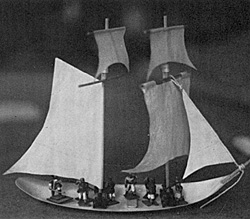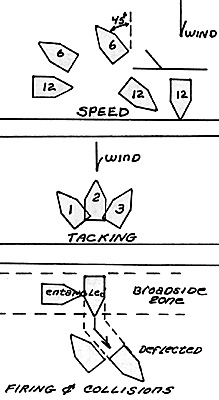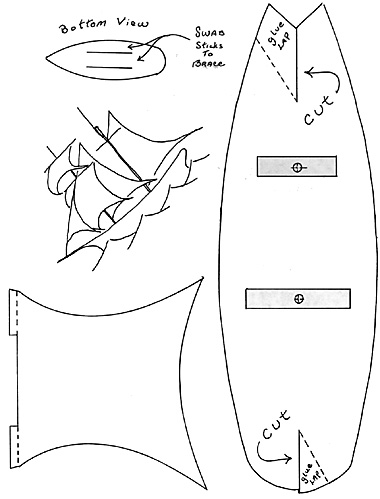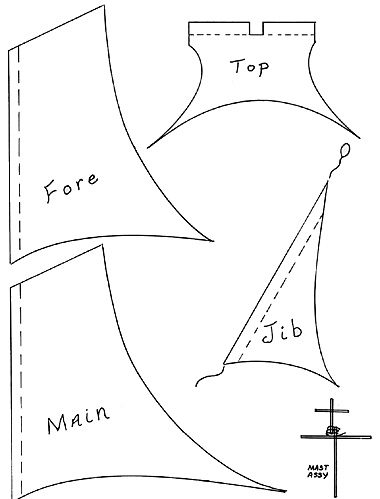
MATERIALS LIST
To Make the Ships:
- Poster Board
Throat Swab Sticks or 1/8" Dowel or both, if available
Popsicle Sticks (from ice cream pops)
Medium Weight Corrasable Bond Typing Paper
Parcel Post Twine
Elmer's Glue
Wax Candle
Drill Bit same size as Throat Swabs or Dowel
Carbon Paper
To Arm and Man the Ships:
- 4 to 6 Cannon
8 to 10 Crew
1 or 2 Off icers
To Play the Game:
- Few Dice
Handful of Pennies
12" Ruler
Index Card with a 45 degree fold
All of the above materials are available in your local drug or hardware store except the cannon and men which may be ordered from Miniature Figurines or Model Shipways, 39 W. Fort Lee Road, Bogota NJ 07603 (catalog $1.50 at this writing). Cannon barrels should be 11/8" long, Carronades 3/4 ", and sailors 25mm or 3/16" scale.
BUILDING INSTRUCTIONS
Trace hull outline onto poster board using carbon paper. Trace alI Iines to make location of parts easier.
Cut out hull outline. Cut along solid line as indicated at each end producing slits at each end.
Pull ends together to form bow and stern by overlapping the ends up to the dotted lines ' Apply glue and hold for about 30 seconds. The glue will bond well enough to let go by then.
Cut two pieces of popsicle stick as per template to make mounting bases for masts. Drill holes to exactly the same size as the masts. All you need is a drill bit which can be twirled between the fingers or clamped in pliers to drill thru the soft wood of the popsicle stick. The mast will be very tight at first. Rub some candle wax on it to ease the fit. Glue the mast mountings into the hull and allow to dry for at least one hour. At this time cut a 11/2" piece of dowl for the bowspirit and glue at the bow with 1/4" projecting. The bow can be creased at this time to form a sharp cutwater and to lower the nose a bit if you prefer. Two swab sticks or dowels may now be glued onto the bottom as shown in the "Bottom View" to give the hull rigidity and to stop side to side rocking. Make the pieces 3" long.
Cut swab sticks to suitable lengths as per mast diagram and glue together. The little top masts can be lashed in place before or after gluing, if desired. Lashing adds to the strength and appearance and makes a handy grabbing point when masts are being pulled to simulate battle damage. Use parcel twine for this and wax it by drawing it across the candle. Waxed twine is much easier to handle. Soak all knots and loops with glue when finished for durability. When gluing yards to masts, notch one slightly to create more contact area for glue to bond. After the joint is dry, put a blob of glue over the whole thing again.
Trace sail patterns onto a folded piece (double thickness) of bond paper (except the small topsail which is a single thickness). The folded edge should be to the left of the pattern. The jib is folded over a piece of twine and glued together to make a permanent assembly. The string should be waxed and have a loop at the top end to slip over the large yardarm on the foremast. The other end is wrapped around the bowsprit and secured with a half hitch. The topsail is glued to the top yard by its tab.
The fore, main, and large square sails are glued together except at the narrow edge on the left of the pattern enclosed by the dotted line. A heavily waxed swab stick is slipped inside to act as a former to make a tubular opening in the sail to accept the mast or yard. As the glue is drying, slide the former back and forth occasionally to keep the opening clear and to prevent the accidental gluing in of the former. Slide completed sails onto masts and yards to complete.
This model can be set up in three different configurations; topsail schooner using fore and aft type sails on fore and main, as a brig by using only square sails, and as a brigantine with square sails on the foremast and fore and aft style main sail on the main mast. Generally, fore and aft rig is faster sailing into the wind and square rig is better with a following wind. The brigantine is a compromise.
GUNS AND CREW
Two or three cannon may be used per side. Glue another length of popsicle stick into the hull about halfway between the other two to hold the third cannon if desired. Minifig and Model Shipways gun carriages straddle the sticks nicely which keeps the guns from sliding all over the deck. If you decide to use carronades, you will have to build a flush deck for them to rest on due to the style of carriage that they come with. (Carronades have only short range fire but cause double damage on all hits scored.)
The crew can vary from ten to twelve, comfortably. Men need not be armed as it is assumed that cutlasses and boarding pikes are close at hand in their -racks when needed.
PLAYING THE GAME
Damage suffered in battle may be marked off by removing sails and masts for rigging hits up to a total of the pieces of sail and masts available (about 5 or 6), and by placing pennies on board to show the number of hull hits. Guns and men are removed as lost.
The ruler provides a handy guide for honest movement of the ships and the index card with the 45 degree angle guides the turns as well as providing a clear definition of the 3" and 6" close ranges. When turning or moving, always use the format as the pivot or point of measurement. This will prevent confusion and the stern of the ship will sweep realistically during turns, sometimes winding up in unexpected places!
One-vs-one games are very enjoyable and usually last an hour. As a general rule you can figure about one hour of playing time for each pair of ships in the game. I have never played with more than six ships so cannot say if this holds true ad infinitum. Two ships can play very nicely on half of a ping pong table (41/2 X 5 ft.). When the edge of the world is reached you can slide the ships an equal distance in any direction desired. Playing within the limits of the table can be a challenge. Mark off a small harbor and assume that reefs line the edges except for narrow entry and exit lanes. Also try placing one small rock or island in the center and watch the dramatic effect this has on the play. Charge a hull damage and a one turn delay against anyone hitting obstacles.
METHOD OF MOVEMENT
 1. Players move alternately. Both movement and firing
take place during your own portion of the turn. Defender
removes all casualties before beginning his move and fire.
The only exception is when a boarding action is in
progress. The defender is then permitted defensive fire,
i.e., small arms of survivors in all cases and swivels and
cannon that did not fire during the previous turn of the
defender.
1. Players move alternately. Both movement and firing
take place during your own portion of the turn. Defender
removes all casualties before beginning his move and fire.
The only exception is when a boarding action is in
progress. The defender is then permitted defensive fire,
i.e., small arms of survivors in all cases and swivels and
cannon that did not fire during the previous turn of the
defender.
2. Ships MUST MOVE AT LEAST 1/2 MOVE each turn unless anchored or luffing and may not begin direction changes until this is done. Generally, a 45 degree turn is permitted after each 1/2 move is completed.
3. Luffing is a stall move in which the bow is intentionally pointed into the wind without any intention of tacking. No movement other than pointing ready for movement next turn is permitted next turn. If ship is not pointed to move, it will drift downwind 3" per turn.
4. When turning the bow thru the wind a 90 degree turn is required. Movement ends upon successful completion of this maneuver. Begin by turning 45 degrees until the bow points straight into the wind's eye and throw a die. If a 6 results the maneuver is not clean and the ship stalls until next turn when you must throw again. Any other number means the turn is successful and the ship is pointed another 45 degrees and stops. Resume movement next turn.
5. Loss of all rigging means dead in the water for one turn while a jury mast is rigged which will allow 1/2 speed movement. One rigging hit will destroy a jury mast but they may be replaced repeatedly.
ODDS AND ENDS
Anchoring: must be announced one turn in advance.
On turn of anchoring move at least 1/2 move (unless luffing) and stop. Tip of bow stays in position while the stern is swung downwind until the bow is facing directly into the wind. Hoisting in the anchor would take too long in a battle situation so we assume they have slipped their cables when leaving anchor and will lose the anchor in the process. Ships are limited to two anchors per game. When at anchor a "spring" may be rigged to the anchor which allows free turning afterwards, but no other movement. It takes one turn to rig a spring.
Raking Fire: when shot will pass the entire length of the ship, all cannon hit effects are doubled. Generally, the rectangular area in which the guns are located is the area that must be raked from one end to the other, in a straight Iine.
Collision: each ship suffers one hull hit, if bow to beam they are entangled as if grappled. if the angle between the ships is less than 45 degrees the moving ship is deflected and they are not entangled, although grappling may be attempted.
Grappling: Attacker assigns a number of men to throw grapples who may do nothing else during the boarding action. One die is thrown per man with each 5 or 6 being a successful grapple. The defender now assigns as many men as desired to cut grapples and must score a 6 for each grapple cut. He may choose to accept grapples and fight with his entire crew.
Morale: When all officers are lost take a morale check.
MOVEMENT
Ships must move 1/2 distance before any turns.
Wind coming from ahead - 6"
Wind from side or rear - 12"
Maximum turn = 45 degrees (90 degrees when tacking)
FIRING
Fire at any time during own move.
| Cannon | Swivel | Muskets |
|---|---|---|
| @24" 5,6 | @24" - no | @24" - no |
| @6" 3+ | @6" 5,6 | @6" - no |
| @3" 2+ | @3" 3+ | @3" - 5,6 |
Sharpshooter - One marine may be designated to fire at officers only. A six is a hit.
Land Cannon - Add 6" to long range and improve hit roll by + 1.
| Hit Result | |||
|---|---|---|---|
| Die | Shot | Grape | Swivel |
| 1 | 1 gun | miss | 1 crew |
| 2 | 1 crew | 1 crew | 1 crew |
| 3 | 1 crew | 1 crew | 1 crew |
| 4 | 1 hull | 1 crew | 1 crew |
| 5 | 1 hull | 1 crew | 1 crew |
| 6 | rigging | rig. and 1 crew | officer |
Damage Limits
- Hull = 8
Rigging = 3
Jury Mast = 1
Morale
- 1, 2, 3, 4 = surrender
5, 6 = fight on, replace 1 officer
Minimum gun crew = 1 man
All Officers lost = morale check
Ship vs Land Cannon - use regular hit result except 4, 5, 6 are misses.
Land Cannon: Large guns: hits cause double damage. "Hot shot" takes two turns to load and can start fires. Throw a third die, 5, 6 = fire; Small guns: hull hits are misses. No "hot shot".
Fires and Firefighting: "Hot shot" causes normal shot damage on turn it hits. If not extinguished on next turn causes one damage each to hull, rigging and men and throw a die, if a 1, ship explodes. To extinguish, men must be assigned to fight and may do nothing else this turn. Need a six for each fire (similar to cut grapples).
Boarding: Attacker moves, fires, and grapples. Defender removes casualties and uses any defensive fire. Both calculate as follows with men available for melee (sailors = 1, marines and officers = 2 pts): Number of men X value X die roll, divide by 10. Loser removes point difference, marines first. If attack loses, boarders are repulsed, if defender loses, deck has been gained and one more consecutive loss of melee will lose ship. Fight 3 rounds per turn.


Back to Table of Contents -- Courier Vol. IV #6
To Courier List of Issues
To MagWeb Master Magazine List
© Copyright 1983 by The Courier Publishing Company.
This article appears in MagWeb (Magazine Web) on the Internet World Wide Web.
Other military history articles and gaming articles are available at http://www.magweb.com